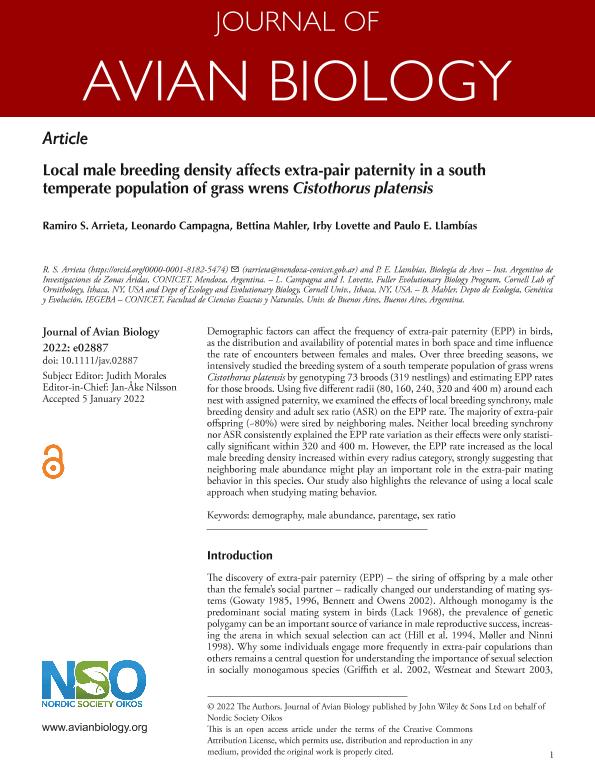Artículo
Local male breeding density affects extra-pair paternity in a south temperate population of grass wrens Cistothorus platensis
Fecha de publicación:
01/2022
Editorial:
Wiley Blackwell Publishing, Inc
Revista:
Journal Of Avian Biology
ISSN:
0908-8857
Idioma:
Inglés
Tipo de recurso:
Artículo publicado
Clasificación temática:
Resumen
Demographic factors can affect the frequency of extra-pair paternity (EPP) in birds, as the distribution and availability of potential mates in both space and time influence the rate of encounters between females and males. Over three breeding seasons, we intensively studied the breeding system of a south temperate population of grass wrens Cistothorus platensis by genotyping 73 broods (319 nestlings) and estimating EPP rates for those broods. Using five different radii (80, 160, 240, 320 and 400 m) around each nest with assigned paternity, we examined the effects of local breeding synchrony, male breeding density and adult sex ratio (ASR) on the EPP rate. The majority of extra-pair offspring (~80%) were sired by neighboring males. Neither local breeding synchrony nor ASR consistently explained the EPP rate variation as their effects were only statistically significant within 320 and 400 m. However, the EPP rate increased as the local male breeding density increased within every radius category, strongly suggesting that neighboring male abundance might play an important role in the extra-pair mating behavior in this species. Our study also highlights the relevance of using a local scale approach when studying mating behavior.
Palabras clave:
DEMOGRAPHY
,
MALE ABUNDANCE
,
PARENTAGE
,
SEX RATIO
Archivos asociados
Licencia
Identificadores
Colecciones
Articulos(IADIZA)
Articulos de INST. ARG DE INVEST. DE LAS ZONAS ARIDAS
Articulos de INST. ARG DE INVEST. DE LAS ZONAS ARIDAS
Articulos(IEGEBA)
Articulos de INSTITUTO DE ECOLOGIA, GENETICA Y EVOLUCION DE BS. AS
Articulos de INSTITUTO DE ECOLOGIA, GENETICA Y EVOLUCION DE BS. AS
Citación
Arrieta, Ramiro Santiago; Campagna, Leonardo; Mahler, Bettina; Lovette, Irby; Llambias, Paulo; Local male breeding density affects extra-pair paternity in a south temperate population of grass wrens Cistothorus platensis; Wiley Blackwell Publishing, Inc; Journal Of Avian Biology; 2022; 4; 1-2022; 1-9
Compartir
Altmétricas




